SLVSC31D December 2013 – August 2015 TPS7A4501-SP
PRODUCTION DATA.
- 1 Features
- 2 Applications
- 3 Description
- 4 Revision History
- 5 Description (continued)
- 6 Pin Configuration and Functions
- 7 Specifications
- 8 Detailed Description
- 9 Application and Implementation
- 10Power Supply Recommendations
- 11Layout
- 12Device and Documentation Support
- 13Mechanical, Packaging, and Orderable Information
パッケージ・オプション
メカニカル・データ(パッケージ|ピン)
サーマルパッド・メカニカル・データ
発注情報
7 Specifications
7.1 Absolute Maximum Ratings
over operating free-air temperature (unless otherwise noted) (1)| MIN | MAX | UNIT | |||
|---|---|---|---|---|---|
| VIN | Input voltage | IN | –22 | 22 | V |
| OUT | –22 | 22 | |||
| Input-to-output differential(2) | –22 | 22 | |||
| ADJ | –7 | 7 | |||
| SHDN | –22 | 22 | |||
| Tlead | Maximum lead temperature (10-s soldering time) | 260 | °C | ||
| TJ | Maximum operating junction temperature | 150 | °C | ||
| Tstg | Storage temperature | –65 | 150 | °C | |
(1) Stresses beyond those listed under Absolute Maximum Ratings may cause permanent damage to the device. These are stress ratings only, which do not imply functional operation of the device at these or any other conditions beyond those indicated under Recommended Operating Conditions. Exposure to absolute-maximum-rated conditions for extended periods may affect device reliability.
(2) Absolute maximum input-to-output differential voltage cannot be achieved with all combinations of rated IN pin and OUT pin voltages. With the IN pin at 22 V, the OUT pin may not be pulled below 0 V. The total measured voltage from IN to OUT can not exceed ±22 V.
7.2 ESD Ratings
| VALUE | UNIT | |||
|---|---|---|---|---|
| V(ESD) | Electrostatic discharge | Human body model (HBM), per ANSI/ESDA/JEDEC JS-001, all pins(1) | 4000 | V |
(1) JEDEC document JEP155 states that 500-V HBM allows safe manufacturing with a standard ESD control process.
7.3 Recommended Operating Conditions
over operating junction temperature range (unless otherwise noted)| MIN | NOM | MAX | UNIT | ||
|---|---|---|---|---|---|
| TJ | Operating junction temperature | –55 | 125 | °C | |
7.4 Thermal Information
| THERMAL METRIC(1) | TPS7A4501-SP | UNIT | ||
|---|---|---|---|---|
| U (CFP) | HKU (CFP) | |||
| 10 PINS | 10 PINS | |||
| RθJA | Junction-to-ambient thermal resistance | 86.6 | 51.9 | °C/W |
| RθJC(bot) | Junction-to-case (bottom) thermal resistance(2) | 10.3 | 6.6 | °C/W |
| RθJB | Junction-to-board thermal resistance | 35.6 | 31.5 | °C/W |
| ψJT | Junction-to-top characterization parameter | 31.7 | 5.42 | °C/W |
| ψJB | Junction-to-board characterization parameter | 53.5 | 31 | °C/W |
(1) For more information about traditional and new thermal metrics, see the Semiconductor and IC Package Thermal Metrics application report, SPRA953.
(2) The junction-to-case (bottom) thermal resistance is obtained by simulating a cold plate test on the exposed (power) pad. No specific JEDEC standard test exists, but a close description can be found in the ANSI SEMI standard G30-88.
7.5 Electrical Characteristics (5962-1222402VHA and 5962-1222402V9A)
over operating junction temperature range TJ = –55°C to 125°C (unless otherwise noted)| PARAMETER | TEST CONDITIONS | TJ | MIN | TYP(9) | MAX | UNIT | ||
|---|---|---|---|---|---|---|---|---|
| VIN | Minimum input voltage(1)(2) | ILOAD = 500 mA | 25°C | 1.9 | 2.3 | V | ||
| ILOAD = 750 mA | Full range | 2.1 | 2.5 | |||||
| VADJ | ADJ pin voltage(1)(3) | VIN = 2.21 V, ILOAD = 1 mA | 25°C | 1.196 | 1.21 | 1.224 | V | |
| VIN = 2.5 to 20 V, ILOAD = 1 to 750 mA | Full range | 1.174 | 1.21 | 1.246 | ||||
| Line regulation(1) | ΔVIN = 2.21 to 20 V, ILOAD = 1 mA |
Full range | 1.5 | 4.5 | mV | |||
| Load regulation(1) | VIN = 2.5 V, ΔILOAD = 1 to 750 mA | 25°C | 2 | 8 | mV | |||
| Full range | 18 | |||||||
| VDO | Dropout voltage (VOUT = 2.4 V) (5)(4)
|
ILOAD = 1 mA | 25°C | 0.02 | 0.05 | V | ||
| Full range | 0.07 | |||||||
| ILOAD = 100 mA | 25°C | 0.085 | 0.10 | |||||
| Full range | 0.13 | |||||||
| ILOAD = 500 mA | 25°C | 0.17 | 0.21 | |||||
| Full range | 0.27 | |||||||
| ILOAD = 750 mA | 25°C | 0.20 | 0.27 | |||||
| Full range | 0.33 | |||||||
| IGND | GND pin current(4)(6)
VIN = 2.5 V |
ILOAD = 0 mA, | Full range | 1 | 1.5 | mA | ||
| ILOAD = 1 mA | Full range | 1.1 | 1.6 | |||||
| ILOAD = 100 mA | Full range | 3.3 | 7 | |||||
| ILOAD = 500 mA | Full range | 15 | 30 | |||||
| ILOAD = 750 mA | Full range | 28 | 45 | |||||
| eN(11) | Output voltage noise | COUT = 22 μF, ILOAD = 750 mA, VIN = 7 V, VOUT= 5 V BW = 10 Hz to 100 kHz |
25°C | 50 | μVRMS | |||
| IADJ | ADJ pin bias current(1)(7) | 25°C | 3 | 7 | μA | |||
| Shutdown threshold | VOUT = OFF to ON | Full range | 0.9 | 2 | V | |||
| VOUT = ON to OFF | Full range | 0.15 | 0.75 | |||||
| ISHDN | SHDN pin current | VSHDN = 0 V | 25°C | 0.01 | 1 | μA | ||
| VSHDN = 20 V | 25°C | 3 | 20 | |||||
| Quiescent current in shutdown | VIN = 6 V, VSHDN = 0 V | 25°C | 0.01 | 1 | μA | |||
| Ripple rejection(10) | VIN – VOUT = 1.5 V (avg), VRIPPLE = 0.5 VP-P, ƒRIPPLE = 120 Hz, ILOAD = 0.75 A |
25°C | 60 | 68 | dB | |||
| ILIMIT | Current limit(10) | VIN = 7 V, VOUT = 0 V | 25°C | 1.7 | 1.9 | A | ||
| VIN = 2.5 V | Full range | 1.6 | 1.9 | |||||
| IIL | Input reverse leakage current | VIN = –20 V, VOUT = 0 V | Full range | 300 | μA | |||
| IRO | Reverse output current(8) | VOUT = 1.21 V, VIN < 1.21 V | 25°C | 300 | 500 | μA | ||
| TSD | Thermal shutdown temperature | 175 | °C | |||||
(1) The TPS7A4501 is tested and specified for these conditions with the ADJ pin connected to the OUT pin.
(2) Dropout voltages are limited by the minimum input voltage specification under some output voltage/load conditions.
(3) Operating conditions are limited by maximum junction temperature. The regulated output voltage specification does not apply for all possible combinations of input voltage and output current. When operating at maximum input voltage, limit the output current range. When operating at maximum output current, limit the input voltage range.
(4) To satisfy requirements for minimum input voltage, the TPS7A4501 is tested and specified for these conditions with an external resistor divider (two 4.12-kΩ resistors) for an output voltage of 2.4 V. The external resistor divider adds a 300-µA DC load on the output.
(5) Dropout voltage is the minimum input-to-output voltage differential needed to maintain regulation at a specified output current. In dropout, the output voltage is equal to: VIN – VDROPOUT.
(6) GND pin current is tested with VIN = 2.5 V and a current source load. The GND pin current decreases at higher input voltages.
(7) ADJ pin bias current flows into the ADJ pin.
(8) Reverse output current is tested with the IN pin grounded and the OUT pin forced to the rated output voltage. This current flows into the OUT pin and out the GND pin.
(9) Typical values represent the likely parametric nominal values determined at the time of characterization. Typical values depend on the application and configuration and may vary over time. Typical values are not ensured on production material.
(10) Parameter is specified by characterization for KGD and is not tested in production.
(11) Parameter is specified by bench characterization and is not tested in production.
7.6 Electrical Characteristics (5962R1222403VXC and 5962R1222403V9A)
Over operating junction temperature range TJ = –55°C to 125°C (unless otherwise noted)| PARAMETER | TEST CONDITIONS | TJ | MIN | TYP(10) | MAX | UNIT | ||
|---|---|---|---|---|---|---|---|---|
| VIN | Minimum input voltage(1)(2) | ILOAD = 1.5 A | Full range | 2.1 | 2.9 | V | ||
| VADJ | ADJ pin voltage(1)(3) | VIN = 2.9 to 20 V, ILOAD = 1 mA to 1.5 A | Full range | 1.174 | 1.21 | 1.246 | V | |
| Line regulation(1) | ΔVIN = 2.9 to 20 V, ILOAD = 1 mA | Full range | 2.5 | 6.5 | mV | |||
| Load regulation(1) | VIN = 2.9 V, ΔILOAD = 1 mA to 1.5 A | 25°C | 2 | 10 | mV | |||
| Full range | 18 | |||||||
| VDO | Dropout voltage (VOUT = 19.3 V )(6)(5)
|
ILOAD = 1 mA | 25°C | 0.08 | 0.32 | V | ||
| Full range | 0.40 | |||||||
| ILOAD = 100 mA | 25°C | 0.14 | 0.40 | |||||
| Full range | 0.58 | |||||||
| ILOAD = 500 mA | 25°C | 0.25 | 0.40 | |||||
| Full range | 0.60 | |||||||
| ILOAD = 750 mA | 25°C | 0.30 | 0.40 | |||||
| Full range | 0.62 | |||||||
| ILOAD = 1 A | 25°C | 0.34 | 0.45 | |||||
| Full range | 0.65 | |||||||
| ILOAD = 1.25 A | 25°C | 0.40 | 0.50 | |||||
| Full range | 0.68 | |||||||
| ILOAD = 1.5 A | 25°C | 0.45 | 0.60 | |||||
| Full range | 0.75 | |||||||
| IGND | GND pin current(4)(7)
VIN = 2.9 V |
ILOAD = 0 mA | Full range | 1 | 1.5 | mA | ||
| ILOAD = 1 mA | Full range | 1.1 | 1.6 | |||||
| ILOAD = 100 mA | Full range | 3.3 | 7 | |||||
| ILOAD = 500 mA | Full range | 8.5 | 30 | |||||
| ILOAD = 750 mA | Full range | 15 | 45 | |||||
| ILOAD = 1 A | Full range | 25 | 50 | |||||
| ILOAD = 1.25 A | Full range | 36 | 80 | |||||
| ILOAD = 1.5 A | Full range | 53 | 105 | |||||
| eN(13) | Output voltage noise | COUT = 22 μF, ILOAD = 1.5 A, VIN = 5.5 V, VOUT = 5 V BW = 10 Hz to 100 kHz |
25°C | 50 | μVRMS | |||
| IADJ | ADJ pin bias current(1)(8) | 25°C | 3 | 7 | μA | |||
| Full range | 5.5 | 15 | ||||||
| Shutdown threshold | VOUT = OFF to ON | Full range | 0.9 | 2 | V | |||
| VOUT = ON to OFF | Full range | 0.15 | 0.75 | |||||
| ISHDN | SHDN pin current | VSHDN = 0 V | Full range | 0.01 | 1 | μA | ||
| VSHDN = 20 V | Full range | 3 | 20 | |||||
| Quiescent current in shutdown | VIN = 6 V, VSHDN = 0 V | Full range | 0.01 | 10 | μA | |||
| VIN = 6 V, VSHDN = 0 V, Post 100kRads (si), TJ = 25°C(11) | 25°C | 15 | 50 | |||||
| Ripple rejection(12) | VIN – VOUT = 1.5 V (avg), VRIPPLE = 0.5 VP-P, ƒRIPPLE = 120 Hz, ILOAD = 0.75 A |
25°C | 60 | 68 | dB | |||
| Full range | 58 | 63 | ||||||
| VIN – VOUT = 1.5 V (avg), VRIPPLE = 0.5 VP-P, fRIPPLE = 120 Hz, ILOAD = 1.5 A |
25°C | 50 | 60 | |||||
| Full range | 44 | 52 | ||||||
| ILIMIT | Current limit(12) | VIN = 7 V, VOUT = 0 V | Full range | 1.7 | 1.9 | A | ||
| VIN = 2.9 V | Full range | 1.6 | 1.9 | |||||
| IIL | Input reverse leakage current | VIN = –20 V, VOUT = 0 V | Full range | 300 | μA | |||
| IRO | Reverse output current(9) | VOUT = 1.21 V, VIN < 1.21 V | Full range | 300 | 500 | μA | ||
| TSD | Thermal shutdown temperature | 175 | °C | |||||
(1) The TPS7A4501 is tested and specified for these conditions with the ADJ pin connected to the OUT pin.
(2) Dropout voltages are limited by the minimum input voltage specification under some output voltage/load conditions.
(3) Operating conditions are limited by maximum junction temperature. The regulated output voltage specification does not apply for all possible combinations of input voltage and output current. When operating at maximum input voltage, limit the output current range. When operating at maximum output current, limit the input voltage range.
(4) To satisfy requirements for minimum input voltage, the TPS7A4501 is tested and specified for these conditions with an external resistor divider (two 4.12-kΩ resistors) for an output voltage of 2.4 V. The external resistor divider adds a 300-µA DC load on the output.
(5) To satisfy requirements for minimum input voltage, the TPS7A4501 is tested and specified for these conditions with an external resistor divider (one 4.12-kΩ resistor and one 61.9-kΩ) for an output voltage of 19.3 V. The external resistor divider adds a 300-µA DC load on the output.
(6) Dropout voltage is the minimum input to output voltage differential needed to maintain regulation at a specified output current. In dropout, the output voltage is equal to: VIN – VDROPOUT.
(7) GND pin current is tested with VIN = 2.9 V and a current source load. The GND pin current decreases at higher input voltages.
(8) ADJ pin bias current flows into the ADJ pin.
(9) Reverse output current is tested with the IN pin grounded and the OUT pin forced to the rated output voltage. This current flows into the OUT pin and out the GND pin.
(10) Typical values represent the likely parametric nominal values determined at the time of characterization. Typical values depend on the application and configuration and may vary over time. Typical values are not ensured on production material.
(11) This maximum limit applies to SMD 5962R1222403VXC post 100kRads (Si) test at 25°C.
(12) Parameter is specified by characterization for KGD and is not tested in production.
(13) Parameter is specified by bench characterization and is not tested in production.
7.7 Typical Characteristics
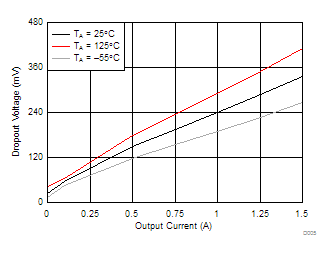
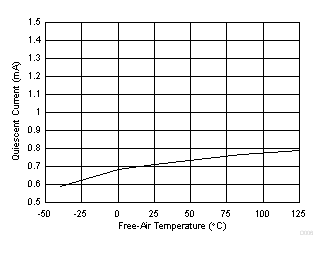
| VIN = 6 V | IOUT = 0 A | VSHDN = VIN |

| TJ = 25°C | ROUT = 4.3 kΩ | VSHDN = VIN |
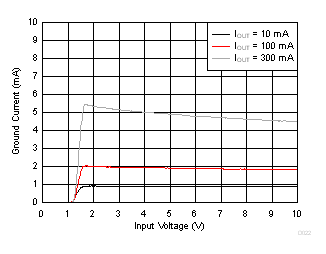
| TJ = 25°C | VSHDN = VIN | VOUT = 1.21 V |
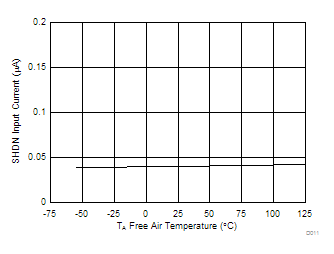
| VSHDN = 0 V |
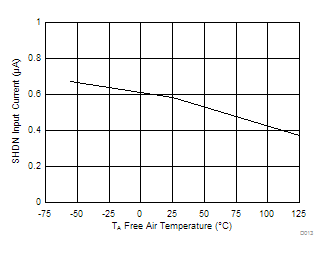
| IOUT = 1 mA |
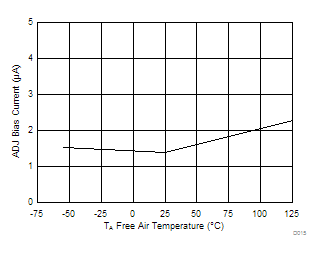
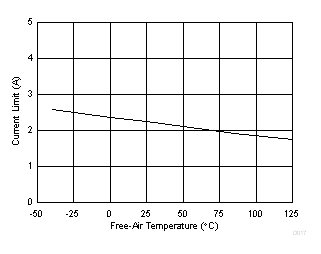
| VIN = 7 V | VOUT = 0 V | |
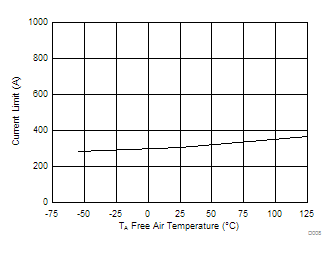
| VIN = 0 V | VOUT = 1.21 V | |
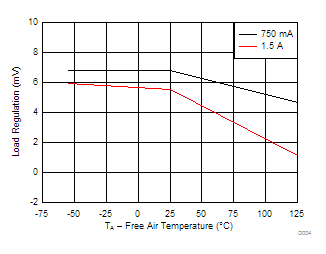
| IOUT = 750 mA | ||||
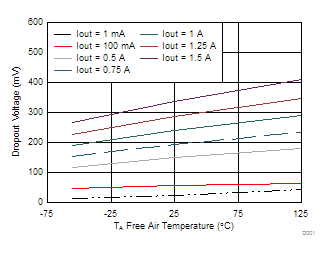
| VOUT = 2.4 V |

| IOUT = 1 mA | VIN = 2.9 V |
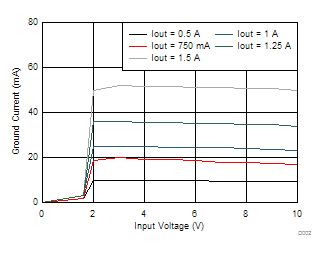
| TJ = 25°C | VSHDN = VIN | |
| VOUT = 1.21 V |
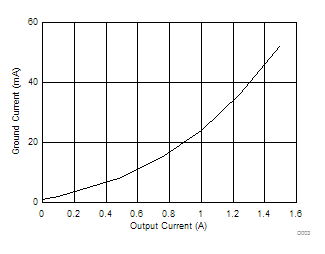
| VIN = VOUT(nom) + 1 |
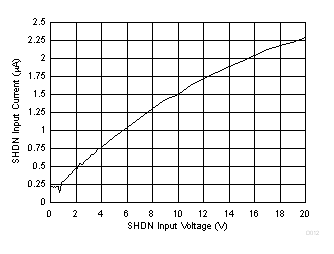
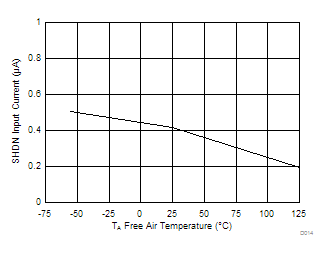
| IOUT = 1 mA |
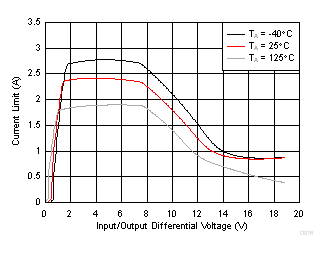
| ΔVOUT = 100 mV |
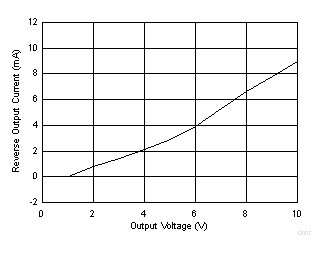
| TJ = 25°C | VIN = 0 V | VOUT = VADJ |
| Current flows into OUT pin | ||
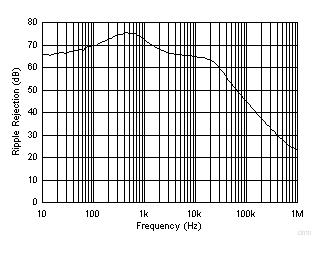
| VIN = 2.7 V | CIN = 0 | COUT = 10 µF |
| (ceramic) | ||
| IOUT = 750 mA | VRipple = 0.05 VPP | TA = 25°C |